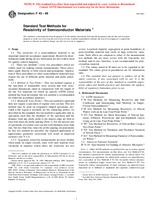Potrebujeme váš súhlas na využitie jednotlivých dát, aby sa vám okrem iného mohli ukazovať informácie týkajúce sa vašich záujmov. Súhlas udelíte kliknutím na tlačidlo „OK“.
ASTM F43-99
Standard Test Methods for Resistivity of Semiconductor Materials (Withdrawn 2003)
Automaticky preložený názov:
Štandardné testovacie metódy pre odpor polovodičových materiálov ( Withdrawn 2003 )
NORMA vydaná dňa 10.12.1999
Informácie o norme:
Označenie normy: ASTM F43-99
Poznámka: NEPLATNÁ
Dátum vydania normy: 10.12.1999
Kód tovaru: NS-55253
Počet strán: 6
Približná hmotnosť: 18 g (0.04 libier)
Krajina: Americká technická norma
Kategória: Technické normy ASTM
Anotácia textu normy ASTM F43-99 :
Keywords:
germanium, resistivity, semiconductor, silicon, ICS Number Code 29.045 (Semiconducting materials)
Doplňujúce informácie
| 1. Scope |
|
This standard was transferred to SEMI (www.semi.org) May 2003 1.1 The resistivity of a semiconductor material is an important materials acceptance requirement. Resistivity determinations made during device fabrication are also widely used for quality control purposes. 1.2 These test methods cover two procedures which are widely used for making routine measurements. These procedures apply directly to both silicon and germanium. Application of these procedures to other semiconductor materials may require the use of different probe material and probe attachment. 1.2.1 Method A, Two-Probe -This test method requires a bar specimen of measurable cross section and with cross-sectional dimensions small in comparison with the length of the bar. For materials for which no specific ASTM referee method has been developed, this test method is recommended for materials acceptance purposes. 1.2.2 Method B, Four-Probe -This test method is rapid and does not require a specimen of regular cross section. This test method may be used on irregularly shaped specimens, provided a flat region is available for the contacting probes. As described in this standard, this test method is applicable only to specimens such that the thickness of the specimen and the distance from any probe point to the nearest edge are both at least four times the probe spacing (Note 1). For the special case of specimens of circular cross section with thickness more than one, but less than four, times the probe spacing, measurements by this test method are possible; the required application of approximate geometric corrections will result in improved accuracy (see 9.1.3). 1.2.3 In general, resistivity measurements are most reliable when made on single crystals, since with such material local variations in impurity which affect the resistivity are less severe. Localized impurity segregation at grain boundaries in polycrystalline material may result in large resistivity variations. Such effects are common to either of the measurement test methods but are more severe with the four-probe test method, and its use, therefore, is not recommended for polycrystalline material. 1.3 The values stated in SI units are to be regarded as the standard. The values given in parentheses are for information only. 1.4 This standard does not purport to address all of the safety problems, if any, associated with its use. It is the responsibility of the user of this standard to establish appropriate safety and health practices and determine the applicability of regulatory limitations prior to use. |
Odporúčame:
Aktualizácia technických noriem
Chcete mať istotu, že používate len platné technické normy?
Ponúkame Vám riešenie, ktoré Vám zaistí mesačný prehľad o aktuálnosti noriem, ktoré používate.
Chcete vedieť viac informácií ? Pozrite sa na túto stránku.




 Cookies
Cookies
